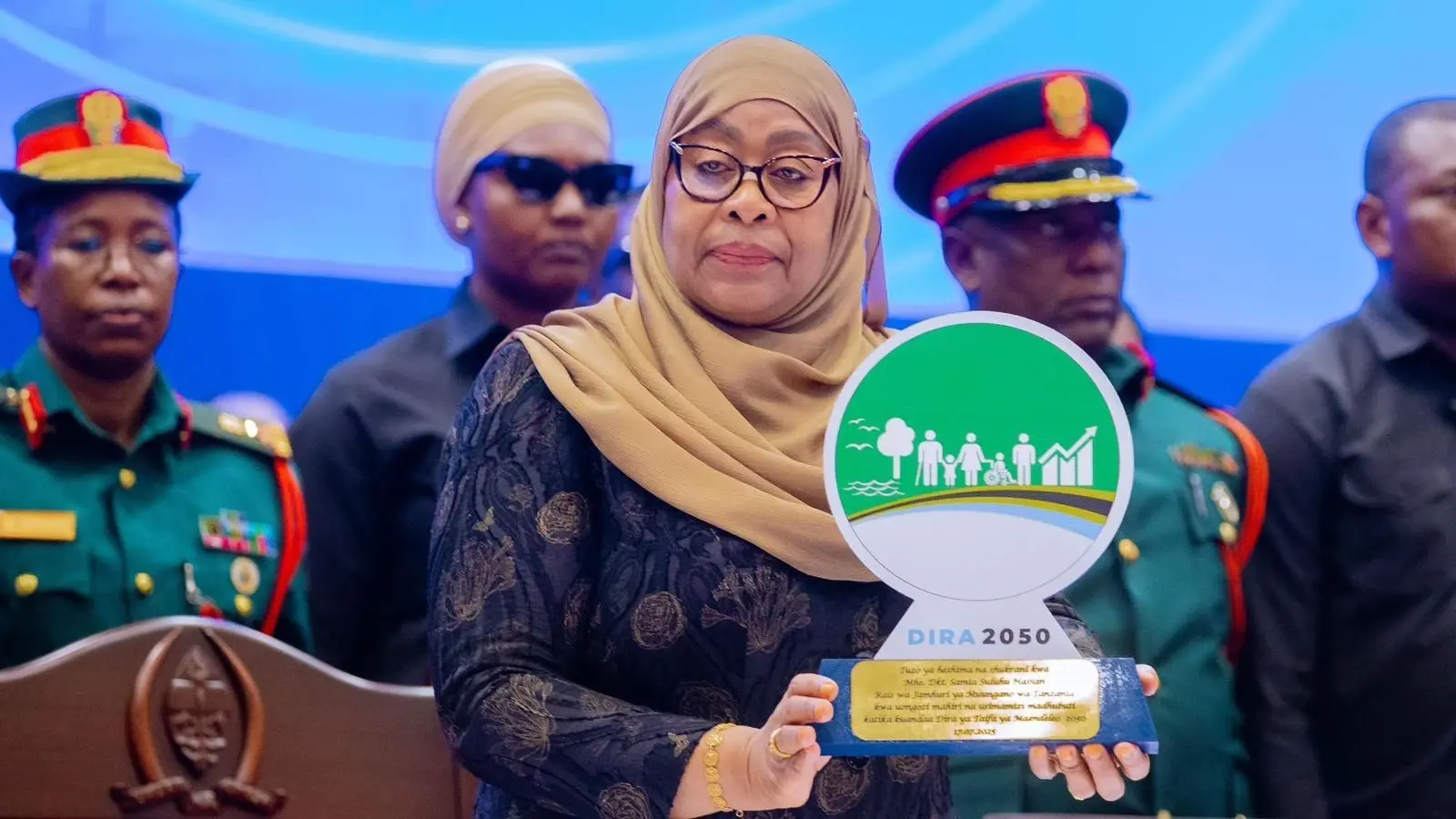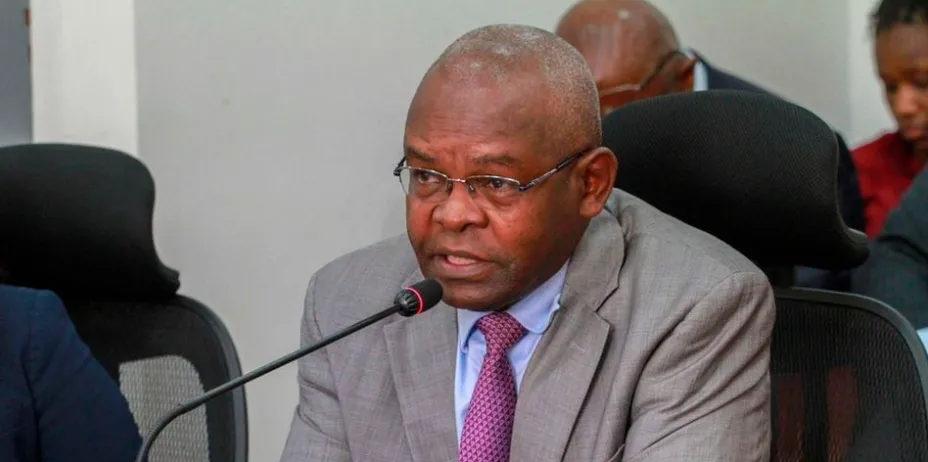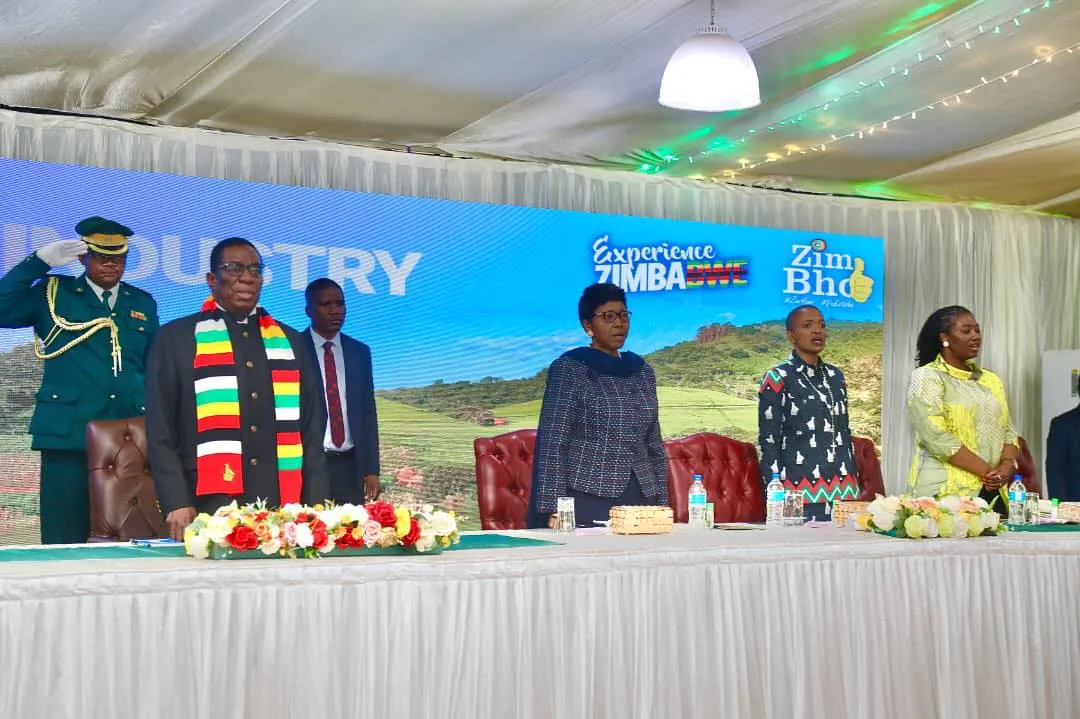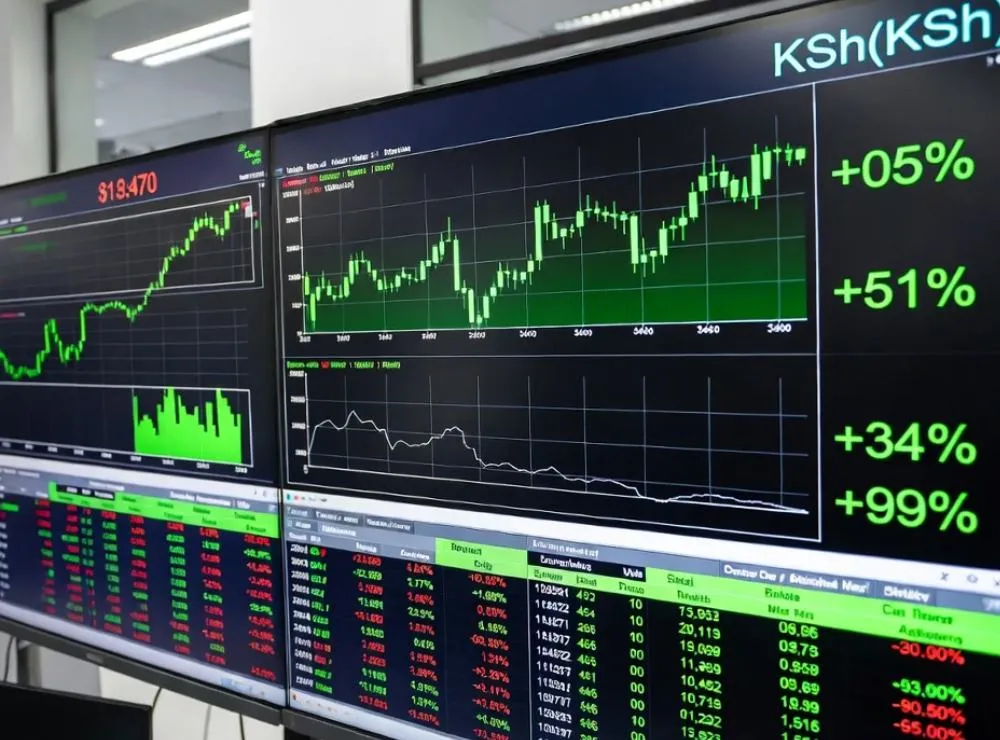In a momentous declaration signaling its ambitious future, Tanzania has officially unveiled its comprehensive long-term development blueprint, Vision 2050. Launched this week by President Samia Suluhu Hassan in the capital Dodoma, the visionary plan sets an audacious target: transforming the East African nation into an upper middle-income country with a staggering $1 trillion GDP by 2050. This ambitious trajectory aims to elevate the lives of all Tanzanians by strategically harnessing the country’s abundant land, vast natural resources, burgeoning demographic dividend, and the transformative power of technology.
The implementation of Vision 2050 is set to commence on July 1, 2026, marking the beginning of a 25-year journey designed to build a strong, competitive, and inclusive economy. At its core, the blueprint emphasizes key sectors such as manufacturing, the digital economy, climate adaptation, and youth empowerment, with the ultimate goal of establishing Tanzania as a regional industrial hub.
President Samia Suluhu Hassan, while launching the blueprint, underscored the foundational principles guiding this monumental undertaking. “We are laying the foundation stone for the future of our people since Tanzania is rich in land and natural resources. Let us go and implement this vision in action, not just in words,” she urged, emphasizing the need for tangible progress over rhetoric. She further directed the Law Reform Commission, in collaboration with the Attorney-General’s Office, to immediately begin drafting legal reform proposals to facilitate the effective and seamless implementation of Vision 2050. This proactive approach to legal and regulatory alignment highlights a commitment to creating an enabling environment for the vision’s success.
The Ambitious Targets: A Leap Towards Prosperity
Vision 2050 is characterized by a set of bold, quantifiable targets that illustrate the scale of Tanzania’s aspirations:
- Economic Growth: The most striking target is the projected increase in GDP from an estimated $85.98 billion in 2025 to an impressive $1 trillion by 2050. This implies an average annual GDP growth rate exceeding 8%, a significant acceleration from current trends. To support this, the IMF projects Tanzania’s real GDP growth to reach 6.0% in 2025 and 6.5% over the medium term, contingent on decisive reform implementation.
- GDP Per Capita: Planning and Investment Minister, Prof. Kitila Mkumbo, revealed that the GDP per capita is expected to surge from the current approximate $1,200 to $7,000 in the next 25 years. This dramatic increase is crucial for elevating the living standards of ordinary Tanzanians and signifies a genuine transition to upper middle-income status. The World Bank classified Tanzania as a lower-middle-income country in July 2020, a status it aims to surpass significantly.
- Human Development: Beyond economic metrics, Vision 2050 places a strong emphasis on human well-being. Officials target to raise the life expectancy for Tanzanians from the current 68 years to 75 years by 2050. This goal will be supported by universal access to quality healthcare, improved sanitation, and enhanced social services.
- Digital Literacy: The plan expects to equip about 70 percent of Tanzanian citizens with digital skills, a crucial step in fostering a knowledge-based economy.
- E-Government Services: A significant push towards digital governance aims for over 80 percent of government services to be delivered online, enhancing efficiency, transparency, and accessibility for citizens and businesses.
These targets are interconnected, forming a holistic approach to national development that recognizes the interplay between economic prosperity, human capital development, and good governance.
Pillars of Transformation: A Multi-Sectoral Approach
Vision 2050 is anchored on several interdependent pillars, each designed to drive specific aspects of Tanzania’s transformation:
1. Strong, Inclusive, Competitive, and Resilient Economy
This pillar aims for an economy driven by domestic productivity, technological advancement, value addition, and global competitiveness.
- Manufacturing and Industrialization: Tanzania aspires to become a regional industrial hub. The industrial sector has been a key focus, recognized as an engine for growth. The strategy involves boosting industrial productivity, with a focus on value addition, particularly in sectors like agro-processing, textiles, and minerals beneficiation. This means moving beyond exporting raw materials to processing them domestically, creating higher-value products, and generating more jobs. The Oxford Academic highlights dynamic sub-sectors like food products, plastics, chemicals, and basic metals as key areas for growth. Recent government directives, such as requiring large-scale gold miners to refine and trade at least 20% of their production locally, underscore this commitment to local beneficiation and strengthening domestic value chains.
- Natural Resources and Blue Economy: Tanzania is immensely rich in natural resources, including minerals (gold, diamonds, tanzanite), vast arable land, significant natural gas reserves, and a long coastline offering immense potential for a “blue economy” (marine resources, fisheries, coastal tourism). Vision 2050 aims to harness these resources sustainably. Recent natural gas discoveries have positioned Tanzania as a potential major gas exporter, with ongoing investments in modular LNG facilities to distribute gas nationwide, lowering energy costs and stimulating industrial competitiveness. The focus will be on ensuring that these resources contribute directly to national development through local content policies, value addition, and equitable benefit sharing.
- Tourism and Hospitality: Tanzania’s iconic wildlife parks (Serengeti, Ngorongoro) and Mount Kilimanjaro, along with its pristine coastline and Zanzibar’s cultural heritage, offer immense tourism potential. The vision will likely focus on expanding tourism infrastructure, diversifying tourism products, and promoting sustainable tourism practices to maximize revenue and job creation.
- Agriculture: Despite its declining share of GDP, agriculture remains the backbone of the Tanzanian economy, employing the majority of the population. Vision 2050 will focus on modernizing agriculture, increasing productivity through improved inputs, irrigation, and technology, and strengthening agro-industries to ensure food security and export growth.
2. Human Capital Development and Social Wellbeing
This pillar aims to build a healthy, educated, skilled, and equitable society.
- Education and Skills Development: Achieving the digital literacy target of 70% of citizens will require significant investment in education, particularly in Science, Technology, Engineering, and Mathematics (STEM) fields. This includes vocational training and re-skilling programs to equip the workforce with the competencies needed for a knowledge-based, industrialized economy.
- Healthcare: Raising life expectancy to 75 years necessitates universal access to high-quality healthcare services, improved maternal and child health outcomes, and robust public health infrastructure.
- Inclusive Service Delivery: The vision emphasizes ensuring that all individuals—regardless of age, ability, or background—can live with dignity, security, and equality, with particular attention to empowering women, youth, and people with disabilities.
3. Environmental Sustainability and Climate Resilience
This pillar recognizes the critical importance of sustainable resource management and building resilience to climate change impacts.
- Climate Adaptation: Tanzania is vulnerable to the impacts of climate change, particularly on its agriculture sector, which is highly dependent on rainfall. The country has adopted various measures to reduce vulnerability, including developing drought-resistant crops and promoting sustainable farming practices. The Green Climate Fund (GCF) is supporting programs like the Tanzania Agriculture Climate Adaptation Technology Deployment Programme (TACATDP) to facilitate access to climate adaptation technologies for farmers. Vision 2050 will likely expand on these efforts, including planting millions of hectares of trees, expanding green industrialization, and investing in renewable energy sources to reduce carbon emissions.
- Sustainable Resource Management: This involves responsible mining practices, sustainable land use, water conservation, and protection of biodiversity to ensure that natural resources are available for future generations.
Cross-Cutting Enablers and Implementation Framework
To support these core pillars, Vision 2050 identifies several cross-cutting enablers:
- Digital Economy and Innovation: This is a central enabler, encompassing robust digital infrastructure (broadband, cloud services, data centers), digital literacy, e-commerce, and the promotion of emerging technologies like AI and blockchain. The Tanzania Communications Regulatory Authority (TCRA) reported over 54.1 million internet users by Q4 2024/2025, a significant leap from 29 million in 2020, demonstrating rapid progress in digital transformation. This growth is fueled by 4G and 5G expansion, fiber-optic infrastructure, and affordable data access.
- Science, Technology, and Innovation (STI) and Research & Development (R&D): Investing in these areas is crucial for fostering innovation, driving productivity, and ensuring that Tanzania remains competitive in a rapidly evolving global landscape.
- Integrated Transport Infrastructure: Modern roads, railways (like the Standard Gauge Railway), air, and marine transport are vital for efficient economic activity, connecting production centers to markets, and facilitating trade. Vision 2025 had a strong focus on infrastructure, and Vision 2050 will build on these achievements.
- Reliable, Affordable, and Clean Energy: Universal access to clean and affordable energy is fundamental for industrialization, economic growth, and improving quality of life. This includes expanding electricity access (targeting 90% by 2050) and diversifying energy sources, with a strong emphasis on renewables and natural gas.
- Good Governance and Inclusivity: President Samia’s emphasis on political cohesion, peace, unity, and strict leadership codes is paramount. Vision 2050 stresses constitutionalism, gender equality, civil liberties, and media freedom as cornerstones of a progressive society. It aims to create a society free from gender-based violence and child abuse, ensuring all individuals can participate meaningfully.
The implementation of Vision 2050 will be guided by a 25-year Long-Term Development Master Plan, which will cascade into Five-Year Development Plans (FYDPs), sectoral strategies, and annual budgets. A Results-Based Management (RBM) approach will be adopted, and the national statistical system will be strengthened for evidence-based policymaking.
The Private Sector’s Crucial Role: A Call for Local Empowerment
While the government sets the vision, the private sector is unequivocally recognized as the primary engine for achieving the ambitious targets of Vision 2050. President Samia’s administration aims to enhance private sector engagement through reforms in the business environment, fostering public-private partnerships (PPPs), and offering sector-specific investment incentives. The goal is for Tanzania to become one of the top three African countries in attracting investment and ease of doing business.
However, a critical voice at the launch came from industrialist Rostam Aziz, a prominent private sector representative. Mr. Aziz lauded the vision but delivered a pointed critique regarding implementation, particularly the reliance on foreign firms for major strategic projects. He noted that substantial funds had been paid out to foreign companies, predominantly Chinese, for project execution, and strongly advocated for empowering local contractors. “Tanzania excels in drafting plans, but we must fix our implementation. Let’s support Tanzanian businesses, especially in access to capital,” he urged.
This sentiment resonates with the broader “local content” debate across Africa, where nations seek to ensure that large-scale investments translate into tangible benefits for local economies, including job creation, skills transfer, and the growth of indigenous businesses. Tanzania’s Mining (Local Content) Regulations, for instance, already mandate minimum levels of Tanzanian employees, use of Tanzanian-licensed service providers, and preference for Tanzanian-incorporated suppliers with specific local ownership thresholds. Mr. Aziz’s call suggests a need to strengthen and broaden the enforcement of such policies across all strategic sectors.
To address the critical issue of human capital development and ensure local participation in high-tech sectors, Mr. Aziz proposed the establishment of a $100 million annual Talent Development Fund. This fund would be dedicated to sponsoring 1,000 Tanzanian youth in critical fields such as Artificial Intelligence (AI), data science, and engineering. Such an initiative would be vital for:
- Bridging the Skills Gap: Equipping Tanzanian youth with advanced digital and technical skills is essential for driving the digital economy and manufacturing sectors envisioned in Vision 2050.
- Fostering Innovation: A skilled local workforce can spur innovation, entrepreneurship, and the development of homegrown solutions to national challenges.
- Reducing Reliance on Expatriates: Building local capacity reduces the long-term need for foreign expertise in critical sectors, ensuring that more value remains within the country.
- Empowering Youth: Investing in youth through education and skills development is paramount for harnessing Tanzania’s demographic dividend, transforming its youthful population into a productive workforce. The Daily News highlighted that Tanzania’s youthful demographic can trigger a demographic dividend, but this requires deliberate investments in employment, education, and health.
Learning from the Past: Vision 2025 and Beyond
Vision 2050 succeeds Vision 2025, which primarily focused on infrastructure development. While Vision 2025 laid crucial groundwork, particularly in transport and energy infrastructure, the new blueprint aims for a broader and deeper transformation. According to the Daily News, Vision 2025 was widely credited for helping Tanzania’s economy remain resilient amid global shocks, contributing to its elevation to lower-middle-income status in July 2020. Achievements under Vision 2025 included significant progress in electricity production, rural electrification, water service coverage, and increased investment projects.
The drafting of Vision 2050 began in April 2023, with a review this year, incorporating lessons learned from Vision 2025 and extensive public consultation, gathering input from over a million Tanzanians. This inclusive approach aims to ensure broad ownership and commitment to the new vision.
Regional Context: Africa’s Long-Term Visions
Tanzania’s Vision 2050 is part of a growing trend across Africa, where nations are articulating ambitious long-term development blueprints to guide their trajectories. Examples include:
- Kenya Vision 2030: Aims to transform Kenya into a newly industrializing, middle-income country providing a high quality of life to all its citizens by 2030, focusing on economic, social, and political pillars.
- Rwanda Vision 2050: Aspires to make Rwanda an upper-middle-income country by 2035 and a high-income country by 2050, emphasizing economic growth, high quality of life, and sustainable development.
These visions reflect a continent-wide commitment to self-determination, sustainable growth, and leveraging Africa’s vast potential to improve the lives of its citizens. Tanzania’s Vision 2050, with its bold targets and comprehensive approach, positions it firmly within this forward-looking continental movement.
Challenges and the Road Ahead
Achieving the ambitious targets of Vision 2050 will undoubtedly present significant challenges:
- Financing: Mobilizing the necessary capital, both domestic and foreign, to fund large-scale projects and initiatives will be crucial. While the private sector is expected to lead, public investment and international partnerships will remain vital.
- Human Capital Development: Ensuring that the rapidly growing population is adequately educated, skilled, and healthy to participate productively in the economy will be a continuous challenge.
- Governance and Rule of Law: Sustaining political cohesion, combating corruption, and strengthening institutions will be essential for maintaining investor confidence and ensuring equitable development.
- Climate Change Impacts: Despite adaptation efforts, Tanzania remains vulnerable to climate change, which could impact agriculture, water resources, and infrastructure.
- Global Economic Volatility: External shocks, such as commodity price fluctuations or global economic slowdowns, could affect Tanzania’s growth trajectory.
- Implementation Capacity: As Rostam Aziz noted, the challenge lies in effective implementation. This requires strong leadership, efficient bureaucracy, and accountability mechanisms.
Despite these hurdles, Tanzania’s Vision 2050 represents a powerful statement of intent and a clear roadmap for the nation’s future. By focusing on strategic investments in key sectors, human capital, and good governance, Tanzania aims to build a prosperous, inclusive, and resilient society.
Conclusion: A Blueprint for a Prosperous Tanzania
President Samia Suluhu Hassan’s launch of Vision 2050 marks a pivotal moment for Tanzania. This comprehensive development blueprint, with its audacious target of a $1 trillion GDP and upper middle-income status by 2050, reflects a deep commitment to transforming the nation’s economic and social landscape. By prioritizing manufacturing, the digital economy, climate adaptation, and youth empowerment, and by strategically leveraging its rich natural resources and demographic dividend, Tanzania is charting a course for unprecedented prosperity.
The emphasis on legal reforms, private sector leadership, and inclusive participation, alongside a candid acknowledgment of past implementation challenges, demonstrates a pragmatic yet determined approach. The call for local empowerment and the establishment of a Talent Development Fund highlight a crucial understanding that true national development must be homegrown, driven by the skills and innovation of its own people.
As Tanzania embarks on this ambitious 25-year journey, the world will be watching. The success of Vision 2050 will not only redefine Tanzania’s place in the global economy but also serve as an inspiring model for sustainable and inclusive development across the African continent. The vision is clear; now, the focus shifts to translating words into action, laying the foundation for a truly prosperous future for all Tanzanians.
Ready to take your career to the next level? Join our dynamic courses: ACCA, HESI A2, ATI TEAS 7 , HESI EXIT , NCLEX – RN and NCLEX – PN, Financial Literacy!🌟 Dive into a world of opportunities and empower yourself for success. Explore more at Serrari Ed and start your exciting journey today! ✨
Photo source: Google
By: Montel Kamau
Serrari Financial Analyst
22nd July, 2025
Article, Financial and News Disclaimer
The Value of a Financial Advisor
While this article offers valuable insights, it is essential to recognize that personal finance can be highly complex and unique to each individual. A financial advisor provides professional expertise and personalized guidance to help you make well-informed decisions tailored to your specific circumstances and goals.
Beyond offering knowledge, a financial advisor serves as a trusted partner to help you stay disciplined, avoid common pitfalls, and remain focused on your long-term objectives. Their perspective and experience can complement your own efforts, enhancing your financial well-being and ensuring a more confident approach to managing your finances.
Disclaimer: This article is for informational purposes only and does not constitute financial advice. Readers are encouraged to consult a licensed financial advisor to obtain guidance specific to their financial situation.
Article and News Disclaimer
The information provided on www.serrarigroup.com is for general informational purposes only. While we strive to keep the information up to date and accurate, we make no representations or warranties of any kind, express or implied, about the completeness, accuracy, reliability, suitability, or availability with respect to the website or the information, products, services, or related graphics contained on the website for any purpose. Any reliance you place on such information is therefore strictly at your own risk.
www.serrarigroup.com is not responsible for any errors or omissions, or for the results obtained from the use of this information. All information on the website is provided on an as-is basis, with no guarantee of completeness, accuracy, timeliness, or of the results obtained from the use of this information, and without warranty of any kind, express or implied, including but not limited to warranties of performance, merchantability, and fitness for a particular purpose.
In no event will www.serrarigroup.com be liable to you or anyone else for any decision made or action taken in reliance on the information provided on the website or for any consequential, special, or similar damages, even if advised of the possibility of such damages.
The articles, news, and information presented on www.serrarigroup.com reflect the opinions of the respective authors and contributors and do not necessarily represent the views of the website or its management. Any views or opinions expressed are solely those of the individual authors and do not represent the website's views or opinions as a whole.
The content on www.serrarigroup.com may include links to external websites, which are provided for convenience and informational purposes only. We have no control over the nature, content, and availability of those sites. The inclusion of any links does not necessarily imply a recommendation or endorsement of the views expressed within them.
Every effort is made to keep the website up and running smoothly. However, www.serrarigroup.com takes no responsibility for, and will not be liable for, the website being temporarily unavailable due to technical issues beyond our control.
Please note that laws, regulations, and information can change rapidly, and we advise you to conduct further research and seek professional advice when necessary.
By using www.serrarigroup.com, you agree to this disclaimer and its terms. If you do not agree with this disclaimer, please do not use the website.
www.serrarigroup.com, reserves the right to update, modify, or remove any part of this disclaimer without prior notice. It is your responsibility to review this disclaimer periodically for changes.
Serrari Group 2025
















